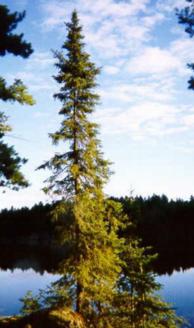

Common Names: Black
Spruce, Bog Spruce, Swamp Spruce, épinette noire
Genus: Picea
Species: mariana
Parts used:

The Black Spruce is a tall tree. It can grow to be twenty-five meters tall. It grows in the taiga biome. As the tree gets older the crown of the tree gets more and more like a spike. The Black Spruce has sharp needles with four sides on them. The needles are blue-green, short, and pointed. They are usually a half an inch long. The bark of the tree is gray-brown. The branches are short and drooping, and are usually layered.
The Black Spruce has pinecones. The pinecones are black and the seeds are usually a purplish-brown. Many animals such as deer, moose and elk do not feed of this plant. The white tailed deer will only eat the saplings under starvation. But many birds eat this plant seeds. The seeds of this tree give the animal's nutrients.
The Black Spruce enjoys colder climates in the northern part of the world. It is all over the taiga forest. It also enjoys poorly drained soil. The Black Spruce is able to survive in the colder climates because of its layered twigs, waxy pine needles, and rough bark. These survival skills protect the Black Spruce from the cold and predators. Also from forest fires. The Black Spruce does not have a special root system.
The Black Spruce is used to build house. It is a good type of wood to make houses because of its layered wood. Layered wood is wood that is very thick and has many layers of bark. Some other values this tree has are, Christmas trees, antiscorbutic beverages, and rope. The Black Spruce is not an endangered species. It is plentiful in the wild.
Erinn L. 2001
Bibliography:
Michael P. Frankis, "Picea mariana", http://www.conifers.org/index.htm (11-2-00)
"EEK-The Black Spruce", http://www.dnr.sta
te.wi.us/org/caer/ce/eek/nature/blkspruce.htm (11-24-00)